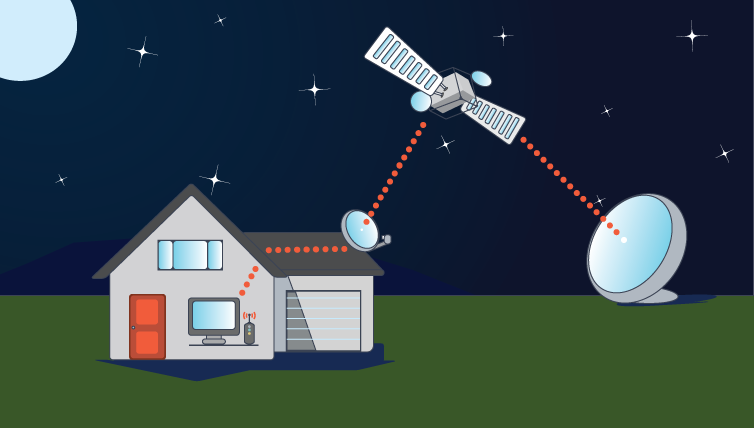Here’s how it works: your provider sends a fiber internet signal to a satellite in space. The internet signal then comes to you and is captured by your satellite dish. Your dish is connected to your modem, which connects your computer to the internet signal. The process reverses back to your provider, and there you have it. Now before we get too thick into the weeds, here’s more information about satellite internet, including resources on which providers are the most reliable. Starlink is launching its own satellites and will be offering internet plans in the future. We have high hopes for improved speeds and prices, but for now, we can only speculate. But note that satellite internet is subject to high latency, so the speeds aren’t always what they seem. Other internet types use better infrastructures to get you more reliable speeds, but they might not be available in your area. We say, if you live in a rural area, it’s still worth getting—especially if it’s your only option. DSL internet can be slower than satellite internet. Depending on the provider you use, DSL ranges anywhere from 5 Mbps to 100 Mbps. If you have access to a DSL provider with modern tech, we think you’ll have a better experience with DSL. But if you can get only slower, older DSL options, you’ll want to consider satellite internet instead. Cable internet is faster and often cheaper than satellite internet. Most cable internet services range between 20 and 1,000 Mbps. But if you live in the countryside, it may not be an option for you. If you have access to fiber internet, don’t bother considering satellite. You’ll find better speeds and prices from fiber providers. Picking a satellite internet plan should be based on what activities you and everyone else in the home plan on doing. Slower speeds will work for web browsing and email checking, but for streaming TV like Netflix, you’ll want faster speeds. But heads up: satellite internet might not have the speeds you need to stream in 4K or HD. Don’t forget that satellite internet comes with data caps. Unlike some cable and fiber plans, satellite internet doesn’t usually come with unlimited data. So once you hit a certain amount of data, your internet provider could start charging an overage fee, or it might throttle your speed. It’s just good to keep your data cap in mind when searching for a satellite internet plan that’s best for you.
Satellite modem: The electronic device that converts the satellites signal into one readable by your computer’s network adapter. It’s what brings the internet to your computer. Router: The electronic device that takes your modem’s internet signal and distributes it throughout your home, either by Wi-Fi or by Ethernet cable.
Satellite internet used to be extremely slow, with download speeds of approximately 750 Kbps. But advancements in technology and new satellites have increased speeds. HughesNet also hopes to boost its speeds up to 100 Mbps in the near future. Thank goodness. Latency is the time it takes for data to be sent and received. In the case of satellite internet, it’s the time it takes for information to go from your device to your satellite dish, to your provider’s orbiting satellite, to a separate satellite dish at your ISP, and back again. As you can see, that’s a lot of steps. And latency has long been a strike against satellite internet. Latency is higher with satellite internet than it is for cable, DSL, and fiber internet. Cable, DSL, and fiber internet have latency in the 20–50 millisecond (ms) range, while satellite internet ranges can be close to 600 ms. Because satellites are positioned 22,000 miles above the earth, satellite internet data just has a long way to travel. It’s also why we basically never recommend satellite internet over other types like cable. But if you live in the country or an area without better internet options, satellite might be your best (and sometimes only) choice. The most obvious effect of latency is on gaming. Gaming that requires ultra-quick responses, like first-person shooters (FPS), just doesn’t work very well with satellite internet. If you choose satellite internet, you might have to say goodbye to League of Legends. But other online activities, like web browsing, emailing, and photo sharing, won’t be affected by latency much at all. Storm-related interruptions are commonly called “rain fade,” and the signal is restored as soon as the storm passes. You can also remove heavy accumulations of snow from around the satellite dish to restore communications. In contrast, a heavy thunderstorm with fallen trees or other extreme weather with similar effects could disable cable or DSL for days. Again, most satellite internet customers live in rural areas without access to DSL or cable, so even with rain fade, satellite internet is preferable to alternative, slower means of internet service (like dial-up internet). Nowadays, you can get a Viasat internet plan starting at $30 a month, or a HughesNet plan starting at $64.99 a month.
